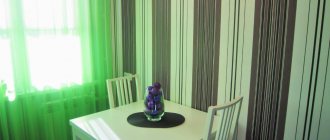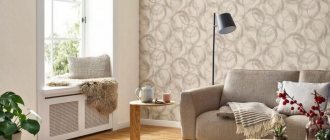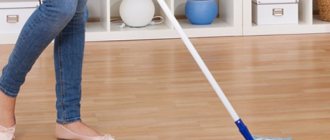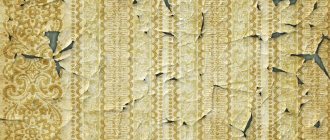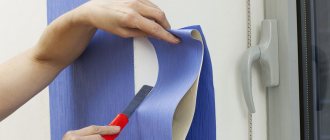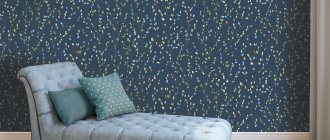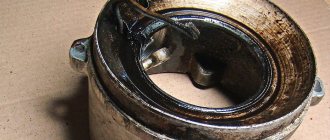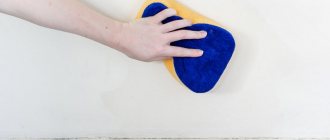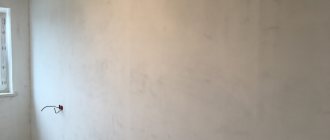Does your wallpaper look a little tired? Over time, dust and moisture can discolor them, leaving wallpapered walls dirtier than the day they were wallpapered.
Someone accidentally smeared a wall in a loved one’s hallway, a little artist decorated the wall upholstery with his “art,” and a greasy stain in the bedroom remained unexplained. But there is no need to give up panic.
We'll show you how to properly clean any dirt from your wall trims.
How to clean wallpaper? Let's first look at the type of wall covering: cleaning paper and tapestry wallpaper will be fundamentally different from cleaning vinyl wallpaper. Rolls of wallpaper are usually marked depending on how much the material can come into contact with water.
Rinse with water
If the pattern of the wall covering does not wear off and remains the same, the wallpaper can be washed. This is the fastest way to clean wallpaper stains, but it has one drawback - it cannot be used on paper wallpaper.
Wallpaper can be washed with water as follows: first select a small wall area that is hidden from view (for example, behind a sofa) and wet it with soapy water and a sponge.
However, before washing, wash the surface of vinyl wallpaper with a dry cloth and wipe with a sponge and soap. After washing, wipe the surface with a damp absorbent cloth to remove excess water.
Causes and ways to eliminate dark spots
This problem is rightfully considered the most serious, because their appearance may indirectly indicate that fungus has appeared under the wallpaper and mold will soon have to be dealt with. As soon as after pasting you notice that black spots have appeared, you should urgently take measures to eliminate them.
Causes of dark marks
Before moving on to active steps to eliminate and decorate dark and sometimes even black marks, you need to understand the reason for their appearance in certain areas of the room. Interestingly, fungus and mold most often appear under the panels, and not on them. There are three reasons for their occurrence:
- Dark spots on the wallpaper can be caused by improperly carried out repairs without treating the walls with an antiseptic.
- Incorrect indoor microclimate: lack of airflow and ventilation and high humidity.
- Wallpapering the wall with rough finishing.
Ways to solve the problem of black spots
In any of the above cases, you should ruthlessly remove the old material from the walls. Without preliminary cleaning, not a single antifungal agent will help you. And even if it helps, it will only be for a short period of time, after which the fungus will again spread between the canvas and the wall. To solve this problem, you must first create a favorable microclimate in the room. Approximate action plan:
- Remove all furniture and textiles from the room.
- Treat all vertical surfaces with a cloth soaked in hydrogen peroxide.
- Remove all remaining coating from the walls.
- To prepare surfaces, sand them thoroughly with sandpaper.
- After this, completely wipe off the dust, or even better, thoroughly wash the prepared surface.
- Apply a professional mold and mildew remover to the entire area.
- After drying, wipe everything with a damp cloth to remove any remaining product and dust.
- And only after applying primer with antifungal and antibacterial properties can you safely begin gluing.
Important! Remember that during all preparatory work, you need to systematically ventilate the room. In addition, it is extremely important for your own safety to carry out work in a special mask that protects the respiratory system.
Eraser or melamine sponge
The easiest way to remove any kind of wallpaper is to remove the simplest office eraser. This can cut off stains left by your fingers. Meanwhile, melamine sponges (the most important modern stain-prevention solution) will help clean even ink stains.
However, remember that these sponges are quite abrasive and can damage the wallpaper pattern, so try on a small area of wallpaper first.
Removing stains from paper wallpaper
Getting rid of any dirt from paper is quite problematic due to its peculiar texture. The main condition is to try to eliminate them fresh .
This requires:
- Brush off dried dirt with a soft-bristled brush. Wash the remains with a melamine sponge soaked in warm water.
- Drawings made with simple or colored pencils can be carefully erased with an eraser.
- Greasy prints from paper wallpaper are removed with warm bread crumbs. It will need to be applied several times. You can treat the stain with a cloth, which must first be soaked in gasoline with the addition of tooth powder.
- Ballpoint pen stains will disappear after treatment with alcohol or acetone. You need to gently wipe them with a moistened hygiene stick without making any effort.
If greasy splatters appear on the paper, you can iron the problem area with the soleplate of a warm iron through a napkin. You need to keep it until the stains are completely removed.
White vinegar or bleach
For vinyl stains caused by water damage, whether mold or tannins, try a bleach or white vinegar solution. Start with a weaker solution and add more bleach or vinegar as needed. Mix ¼ cup of bleach with 1 cup of water. First, test the solution on a small, inconspicuous spot on the wall behind the door.
If the method appears to work after five to ten minutes, continue. Dip a soft sponge into the mixture and remove excess water. Apply the sponge to the stain and leave for five minutes. Remove any remaining bleach with a clean, damp sponge.
For dirt or grease stains on fiberglass wallpaper: Use ½ cup white vinegar mixed with 1 cup water. Apply this solution to the painted part of the wall and place it in the same direction as the wallpaper pattern. Wipe the surface with a sponge soaked in clean water. Next is a dry towel.
Classification of professional cleaning products
Professional chemical cleaning products – Dr.Schnell, Merida, Ecolab. They are produced in the form of powders, gels and sprays.
Before use, powder products are diluted in water and applied to stains.
The concentrated gel should be used with a damp, soft sponge.
The spray is applied to the wall canvas, left for 10 minutes, then wiped with a paper towel or cloth napkin.
Products for home kitchen furniture and mirrors are suitable for wallpaper:
- Pronto – used to remove dust and greasy fingerprints;
- Vanish is a foaming product that removes any dirt.
- Freshbubble – contains baking soda and will cope with greasy stains.
The difference between wallpaper and dirt on it
Wallpaper in kitchens and bathrooms can become coated with sprinklers, smoke and vaporized oils, creating a sticky surface where dust can easily stick and obscure the wall.
Meanwhile, wallpaper in the bathroom, where it is exposed to high humidity and splashing water, can become moldy where it comes into contact with dampness. If it is very saturated, such as due to a leak or burst pipe, water may also seep through the walls and release tannins from the underlying wood, staining your wallpaper.
If you have cellulose, fabric, bamboo, hybrid or removable wallpaper , you can clean it by only lightly dusting or vacuuming the walls. Many natural fibers and fabrics can be damaged by water and cleaning chemicals, so check with the manufacturer before staining.
The exception is vinyl and fiberglass wallpaper - the most durable of all. Either can be cleaned using all-purpose cleaning sprays or the gentle cleaning method described above.
However, be careful to work with non-abrasive chemicals (no powders) and only soft scouring pads or sponges (no scouring pads) to ensure you don't scratch, tear or damage the surface. Do not use scrubs that contain very fine abrasives.
Source
Which wallpapers are washable?
First of all, in order to avoid unpleasant situations and not spoil the coating, let's figure out what wallpaper can be washed. I think everyone understands that paper wallpaper cannot be washed.
Vinyl and non-woven wallpaper are called washable. However, not everyone knows that these fabrics may have different resistance to moisture and cleaning agents. Therefore, manufacturers inform customers about this characteristic of the material using special designations that are applied to the wallpaper packaging :
| Designation | Features of the canvas |
| One wave | Such wallpaper is moisture resistant, but not washable. Therefore, they can only be wiped with a damp cloth, doing this very carefully. In this case, no cleaning agents should be used. |
| Two waves | Fabrics of this type are washable, i.e. they can be washed with soapy water. However, this must be done very carefully. |
| Three waves | Fabrics with this designation are called super washable. They are resistant to water and can be washed using any household detergent. |
| wave with crest | Such fabrics are resistant not only to moisture, but also to friction. Thanks to this, they can be washed using a brush. It is also allowed to clean them with a washing vacuum cleaner. The price of these canvases is the highest, but in some cases their use is quite justified, for example, they are an excellent choice for the work area in the kitchen, as well as for children's rooms. |
Designation of wallpaper resistance to moisture and cleaning
It must be said that not only vinyl and non-woven wallpaper can be washed. Paintable glass wallpapers withstand moisture well. However, it should be borne in mind that a lot depends on the paint with which they are painted. If the paint is not moisture-resistant, then, of course, you cannot wash such wallpaper.
Fiberglass wallpaper is not afraid of moisture
Liquid wallpaper is often used in kitchens. They themselves are not resistant to moisture. This coating can simply be washed off the wall with a wet rag or sponge. However, if liquid wallpaper is varnished, it becomes resistant to moisture.
Another type of wallpaper that often attracts people is paper canvases, as they often have an attractive appearance and are much cheaper than their vinyl counterparts. I already said above that this finishing material does not withstand washing . However, many people are interested in how to cover the wallpaper so that they can be washed?
Wallpaper varnish
It is indeed possible to make such canvases moisture resistant. For these purposes, there are special wallpaper varnishes of the type VAK-A-104 .
People often wonder whether non-woven wallpaper can be washed if its moisture resistance level is unknown. I’ll say right away that all types of this finishing material can withstand wet cleaning. As for more thorough washing, resistance to it can be checked by washing a small inconspicuous area, which, for example, is hidden behind furniture.
How to cover or remove a dirty stain on liquid or paper wallpaper
Interior design is a pretty important thing in the modern world.
After all, the mood of everyone living in the house directly depends on how the room looks. Wallpaper can also become dirty during active use. Most often, this happens in the kitchen, in the hallway and in the children's room. How to prevent such divorces from occurring? How to remove them without damaging the wallpaper? Let's figure it out.
How to wash, procedure
The most common and effective way to wash wallpaper in a room is with soapy water or cleaning products.
- To do this, it is worth conducting an experiment on a small area in order to understand how the wallpaper will react.
- A cleaning agent or soap is rubbed into a container with warm water, a clean rag is dipped into the solution, wrung out and a small area is wiped with gentle movements.
- Afterwards, wipe the surface with a clean, dry cloth.
Once the area is dry, the result will become visible. If you need to repeat the procedure, you should first wait until it dries completely, and then wash the area again.
Frame holders
If there are no special latches on a wooden photo frame at all or they have broken off, this problem can easily be solved with pushpins that are made entirely of metal. You can, of course, use nails, but they will damage the wooden frame.
You can use regular metal snaps to secure photos in the frame.
The edge of the button needs to be bent a little and then “driven” into the wood. It is thanks to this bent tip that the photograph will stay in the frame. If the edge of the button protrudes, it can be easily bent. The photo will be captured securely, and it’s quite easy to get these buttons if necessary.
Experiment result
Of course, you can find a lot more such advice in old Soviet magazines - we checked only a small part of them. As you can see, most of them are quite functional, so you can use them today if necessary, although some may not seem entirely relevant.
Pink spots
If for some reason pink spots appear on the wallpaper, there can be many reasons:
- The appearance of mold - in this case, the stains may increase and begin to darken over time.
- The walls are covered with vinyl wallpaper - this is usually due to the fact that such wallpaper takes a long time to dry, and for this reason the light may be distorted. Over time, the spots will go away on their own.
- The technology for working with the primer was violated.
- The technology for processing the walls was violated, perhaps the reason was a poorly dried layer of plaster or putty. In this case, you will have to remove the wallpaper and wait until everything dries.
Yes, removing grease stains from wallpaper doesn’t seem like such a difficult task!

